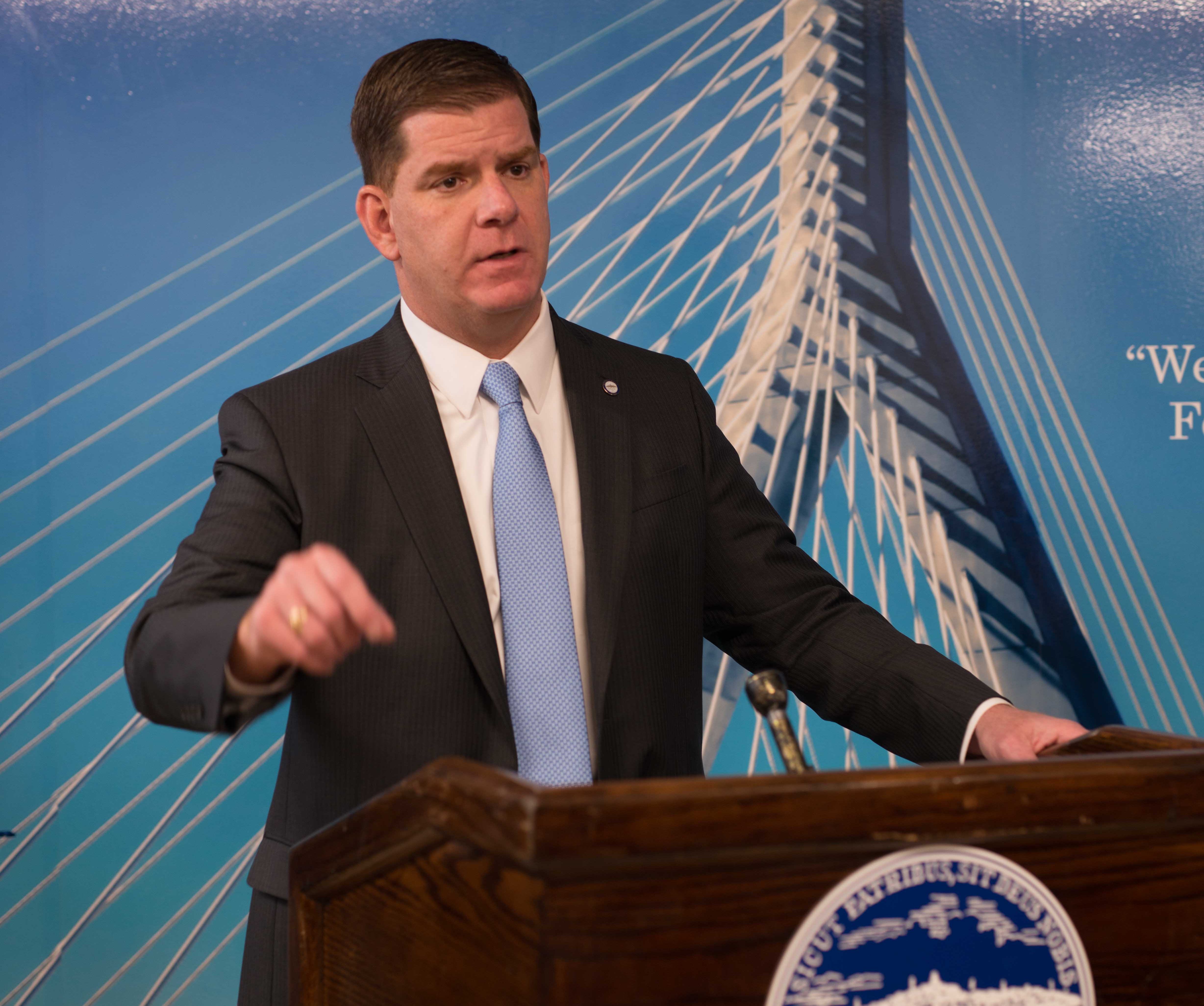Mayor Marty Walsh at the 2014 opening of Southampton Street Shelter. Photo: Zengzheng Wang.
On Thursday, Boston officials announced that their push to end chronic individual homelessness has resulted in housing 301 individuals since the start of 2016. This is in addition to the 846 veterans they have housed since 2015.
The new numbers reflect the progress of Boston’s Way Home, Mayor Marty Walsh’s initiative to end chronic homelessness by 2018. The initiative has already dropped veteran homelessness to a functional zero. It also introduced improved methods to better match newly homeless clients to the services they need.
The numbers also reflect an increase of 121 people housed since the last Boston’s Way Home report in November 2016.
Laila Bernstein, advisor to the mayor for the initiative to end chronic homelessness, presented the new numbers alongside Sheila Dillon, chief of housing and neighborhood development.
These numbers also include 100 more permanent supportive housing units, which provide both stable housing and the resources individuals need to maintain them.
However, officials note that despite housing efforts, the chronically homeless population of Boston remains higher than they’d like. At the beginning of 2016, there were 612 chronically homeless individuals. The city doesn’t have current population numbers available yet, but said the city sees new clients at emergency shelters at a steady rate.
Chronic homelessness, by the way, refers to someone with a disabling condition who repeatedly experiences episodes of homeless or is continuously homeless for over a year. Bernstein noted that the 301 individuals had been homeless for a combined total of 2,000 years.
It’s worth noting that ending chronic individual homelessness doesn’t mean ending homeless all together. Rather it’s about significantly lowering the homeless population, housing chronically homeless clients, and developing a system that houses new shelter clients as quickly as possible.
For example, while the city has achieved a functional zero in veteran homelessness, Boston still sees about 30 new homeless veterans a month, according to Bernstein.
Bernstein said part of the influx may be due to the housing success attracting more people to Boston. Many of the individuals, including vets, come from surrounding communities.
“It’s working, but there’s still a lot more to do” said Bernstein.
Bernstein also said the city’s housing initiatives need more private investments to complement the city’s funding of these services. The city provides some incentives for private landlords to rent to homeless clients, including a landlord guarantee fund which can cover any damages or relocation fees they may incur.
“We need more landlords to step up,” said Bernstein.
Still, the city is confident it can still meet its goal of ending chronic homelessness by 2018.
Boston is also focusing on rapid rehousing efforts, in accordance to the U.S. Department of Housing and Urban Development’s new guidelines. Rapid rehousing services, as the name suggests, aim to get newly homeless folks back into housing as soon as possible. The city often provides financial aid for first and last month rent and security deposits, and clients search for housing on the private market.
Housing surges, which introduce homeless elders to housing providers, have also helped find many folks find homes, sometimes within the same day as the surge, according to Bernstein.
And while many around the country are bracing for how changes in HUD may affect housing and homelessness efforts, Mayor Walsh notes that federal funding is secure through September.
That said, he added the city is prepared is to deal with any shortfalls and noted that the Community Preservation Act will provide the city with more resources to build affordable housing.
The mayor established Boston’s Way Home in 2015, roughly a year after the mayor closed down the Long Island bridge in October 2014. The bridge the only access point to a health campus that at the time contained Boston’s largest homeless shelter and a number of addiction recovery services.
The move drew criticism from local advocates of the homeless and recovery communities. While city built the new Southampton Street Shelter in January 2015 and replaced most of the lost beds from the shelter and recovery as of October 2016, some, like Boston mayoral candidate and city councilor Tito Jackson, have criticized how long the city took in its efforts. (And, more recently, how the city handled the closing of two transitional programs at Southampton, which were originally located at Long Island.)
“We don’t make rich people wait two years for housing. We build luxury towers in less than two years,” Councilor Jackson previously said to Spare Change News.
“Blame me if you want,” said Mayor Walsh. He said city officials like Councilor Jackson could have potentially fixed the bridge years before its closure, but never came out with any plans for repairs — “Where was the councilor in 2011, when he became a councilor, when that bridge was crumbling while those programs were still there?”
He also defended his record as state representative advocating for homeless and recovery programs, including those located on island.
“I fought to get beds for the homelessness, I fought to get beds for programs,” said Mayor Walsh. “It wasn’t popular to fight for recovery programs — I fought for them.”

Leave a Reply
You must be logged in to post a comment.